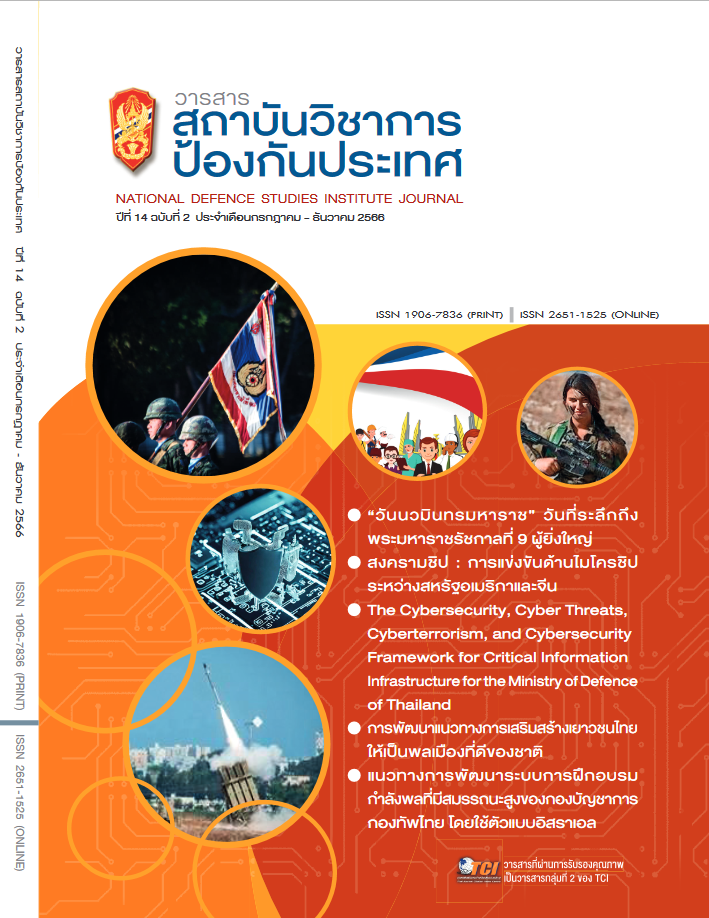Current Situations, Impact Factors and Guidelines for Efficiently Use of Digital Technology in Royal Thai Air Force Affairs
Main Article Content
Abstract
The research aimed to study 1) the influence of fundamental factors in digital technology use towards the current state and guidelines for the use of digital technology of the Royal Thai Air Force civil servants, 2) the influence of the current state towards the guidelines, and 3) develop appropriate guidelines for the use of digital technologies of Air Force civil servants for air force affairs. The sample group used in this research was 400 air force civil service officers in the central and provincial areas. The research tool was a questionnaire. The sample group answered the questionnaire 100%. The statistics used in the data analysis were 1) descriptive statistics (percentage, mean and standard deviation calculated statistics), and 2) hypothesis testing statistics are Multiple Linear Regression Analysis.
The hypothesis test yielded 15 influence equations. The current state influences 1) the guidelines regarding information technology infrastructure development. (R2 = .523), 2) digital technology integration (R2 = .567), 3) developing skills for understanding and using digital technology (R2 = .539), and 4) promotion from superiors (R2 = .516).
Article Details

This work is licensed under a Creative Commons Attribution-NonCommercial-NoDerivatives 4.0 International License.
The articles, images, tables, graphs, written content, and opinions published in this journal are solely those of the authors and do not necessarily reflect the views or positions of the National Defence Studies Institute or its academic affiliates.
References
กองทัพอากาศ. (2563). ยุทธศาสตร์กองทัพอากาศ 20 ปี. สืบค้นวันที่ 31 ธันวาคม 2563, จาก https://rtaf.mi.th/th/ Documents/Publication/RTAF%20Strategy_Final_04122563.pdf
Ekufu, T.K. (2012). Predicting cloud computing technology adoption by organizations: An empirical integration of technology acceptance model and theory of planned behavior (Doctoral dissertation of Philosophy). Capella University.
Hair, J. F., Black, W. C., Babin, B. J., & Anderson, R. E. (2010). Multivariate data analysis (7th ed.). New York: Pearson.
Hanelta, A., Bohnsackb, R., Marzc, D., & Maranteb, C.A. (2021). A Systematic Review of the Literature on Digital Transformation: Insights and Implications for Strategy and Organizational Change. Journal of Management Studies, 58(5). Retrieved from https://onlinelibrary.wiley.com/doi/ epdf/10.1111/joms.12639
Kaiser, H. F. (1974). An Index of factor simplicity. Psychometrika, 39(1), 31-36.
Kaiser, H. F., & Rice, J. (1974). Little Jiffy, Mark IV. Educational and Psychological Measurement, 34(1), 111-117.
Krejcie, R. V., & Morgan, D. W. (1970). Determining sample size for research activities. Educational and Psychological Measurements, 30(3), 607-610.
McKinsey & Company. (2018). Unlocking success in digital transformations. Retrieved from https://www.mckinsey.com/ capabilities/people-and-organizational-performance/our-insights/unlocking-success-in-digital-transformations#/
Ronald, L. P. (2016). IT Governance Practices of Local Government Units (LGUs) in Cavite. Journal of Business Administration and Languages, 4(2), 53-60.


